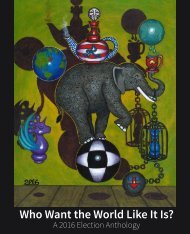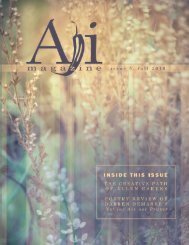Create successful ePaper yourself
Turn your PDF publications into a flip-book with our unique Google optimized e-Paper software.
Merging Past, Present and Future: A Conversation with Alex NodopakaTo reiterate, Nodopaka is fearless—his art comes first. But not everyone has a handle on the secret of existencelike Nodopaka. Do students of art in America today perhaps give up, or give in to commercial temptations,too easily? Nodopaka offered this viewpoint: “I don’t think art students give in; they expect a six-figure incomeright off while other artists give it away. Art for art’s sake is not for the feeble of heart bent on even poverty levelliving. So much for commercialism unless you’re executing company graphics art 8 to 5 for a paying employer.Not that bad of a deal, remember Leonardo?”Lost education.Lost art.Lost audience.Are we doomed?What about passion? Does anyone know what that meansanymore? Nodopaka does: “As for passion for art, it goes backto our youthful years. If we are not exposed to it in school,home and public places, including at least some weekly TV artprograms, there’s little hope for any audience. The dilemma isinside a squirrel cage. We start spinning for nothing and likegunning a car with the clutch on we get nowhere. Besides, bynow after 55 years of nearly absent teaching in the humanitiesin schools, contemporary art since then is about nothing; we lostour audience as long ago, and I admit it does take somethingcalled education. Nothing to sneeze at especially when onegraduates with a $100,000 student debt. Of course they couldrepay it with one Pollock, but who needs more than one Jackson? Besides, one must be learned enough todistinguish the degree of nothingness, as Sartre might’ve said.”Lost education. Lost art. Lost audience. Are we doomed? The conversation concluded with Nodopaka speakingof the future of art in America: “No, we aren’t doomed anymore than the rest of the world was since New Yorksnatched art primacy from Paris. But what if those Europeans hadn’t come to the USA? As for the rest of theart world, their art simply became invisible. I mean, why promote anyone else but our own? As to who will bemaking decisions about future art in America: The same people who do art today and those who write historiesof art (i.e. the most powerful nations of the moment). Who else writes history! Would a popular consensus bevalid? If it were we’d still be at the cave art level, though, mind you, it took 25,000 years for it to be recognized asmodern art. And if there were a popular vote, how legitimate would it be since we already discussed the paucityof art education in America. Forming an art Academy? It already has been done in America, France, SovietRussia, Germany under Hitler—and all failed abysmally for taking politics into account instead of art. Art is astemperamental as an unpractical item. It just disappears from circulation.The definition of art has been as varied and impermanent as there have been makers of art during every historicallife cycle. . . . I cannot speak for the next century about any particular nation, but I can speak for the next minuteabout the next minute of evolution. The international intercontinental advent of mass instant communicationwill cause art to meld through mutual influence. Ethnic original peculiarities will slowly disappear and chewinggum will become the art of the future. What will emerge will be short-lived fads.”1Kandinsky’s book Concerning the Spiritual in Art (1910)25




